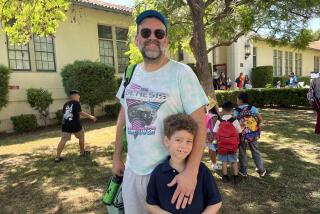‘Fast and hard’: What it was like at epicenter of L.A. earthquake
Monday’s magnitude 4.4 earthquake was centered in a hillside community at the top of Encino, near Mulholland Drive and Sepulveda Boulevard.
For residents of the upscale neighborhood, the quake provided an intense jolt but ended up causing only minor damage.
Debbie Seidel, a 42-year-old mother of two, was getting into her minivan and pulling out of the driveway of her home on Meadowcrest Road.
Before departing, she scrolled through pictures of the quake’s damage on her iPhone.
There was a fallen mirror resting on a chest that managed not to shatter, and her daughter’s shoe rack that had come unhinged and was spilling items to the ground.
Her husband would later text her and write, “Our house is the epicenter.” “It was fast and hard,” she said. “You felt that it was close. It was intense, but super short.”
Seidel said she has heard from some neighbors who report “nothing bad, just scared nerves and curious kids who are living through this for the first time.”
RELATED: Where exactly was the L.A. earthquake?
Robert Ringler, who lives not far from there off Beverly Glen Boulevard, was jolted awake at 6:25 a.m. Moments after the first jolt, he said a second less pronounced round of shaking began.
His dishes rattled, his pictures became misaligned, but his dog Joey slept right through it all. “I’m born and raised here,” the former UCLA administrator said. “And this is the first time I’ve been this close to the epicenter.”
For Ringler and others, the quake was a reminder that a much larger quake is on its way. “It’s a wake-up call,” he said.
The quake was felt over a large area.
Seismologists say Monday’s 4.4 temblor could mark the beginning of the end for L.A.’s years-long “earthquake drought.”
Typically, they would expect a 4.4 earthquake about once a year in the Los Angeles Basin, but that hasn’t happened for years.
“We don’t know if this is the end of the earthquake drought we’ve had over the last few years, and we won’t know for many months,” said Caltech seismologist Egill Hauksson.
It was the most significant shake in Southern California since a 5.5 earthquake hit Chino Hills in 2008.
More to Read
Sign up for Essential California
The most important California stories and recommendations in your inbox every morning.
You may occasionally receive promotional content from the Los Angeles Times.











